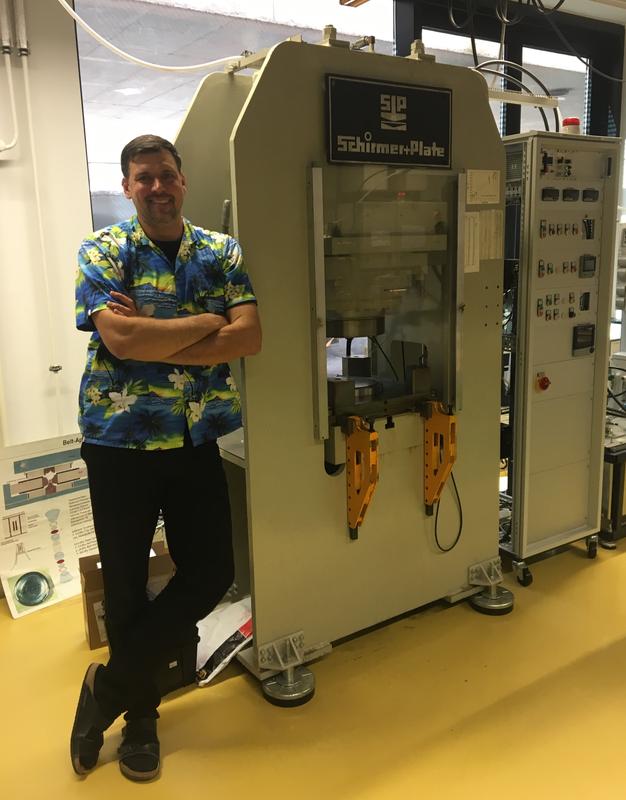News from the diamond nursery

Prof. Horst Marschall in front of one of the high-pressure belt apparatus in the Institute for Geosciences used to simulate the formation of inclusions in diamonds Credit: Horst Marschall, Goethe University
Unlike flawless gems, fibrous diamonds often contain small saline inclusions. These give hints to scientists about the conditions under which diamonds are formed deep in the Earth’s mantle.
A research team including scientists from Goethe University solved the puzzle of the formation of these inclusions by simulating conditions of extreme heat and pressure in the laboratory.
Diamonds are crystals of carbon that form deep in the Earth’s mantle underneath the oldest continents, the cratons. They are transported to the surface of the earth in exotic magmas called kimberlites by explosive volcanic eruptions.
Previous studies had always determined that diamonds include fluids containing sodium and potassium, but the origin of these fluids was unknown.
“In order for these inclusions to form, parts of the Earth’s oceanic crust and their sediment layer had to be submerged beneath the cratonic continents in what is known as a subduction zone. These zones are located at depths of over 110 kilometres at a pressure of over four gigapascals, or 40 thousand times the atmospheric pressure,” explains Michael Förster, the first author of the study that was published in the scientific journal Science Advances.
The submergence of the earth’s crust has to happen quickly so that the diamond can form before the sediment starts to melt at temperatures over 800 degrees Celsius, and react with the cratonic mantle.
For the high-pressure experiment in the laboratory, scientists from Sydney, Mainz and Frankfurt stacked marine sediment and peridotite (rocks from the Earth’s mantle) in four-millimetre capsules and placed them under high pressure and extreme temperatures. At pressures of four to six gigapascals – corresponding to depths of 120 to 180 kilometres – small salt crystals formed from the reaction between the two layers.
Their potassium to sodium ratio corresponded exactly to the saline fluid inclusions in diamonds. In experiments with less pressure, corresponding to depths of less than 110 kilometres, these salts were not present. Instead, potassium was absorbed from the recycled sediment by mica.
“Unlike previous models that attributed the source of the salts to seawater, the sediments represent a plausible source of potassium,” says the mineralogist Professor Horst Marschall from Goethe University. “The potassium concentration in seawater is too low to explain the saline inclusions in diamonds.” Magnesium-rich carbonates, important components of the kimberlites, also came about as a by-product of the reaction.
Publication: Michael W. Förster, et al. Melting of sediments in the deep mantle produces saline fluid inclusions in diamonds, in Science Advances, Vol.5 No. 5, DOI: DOI: 10.1126/sciadv.aau2620; https://advances.sciencemag.org/content/5/5/eaau2620
A picture may be downloaded here: http://www.uni-frankfurt.de/78861524
Caption: Prof. Horst Marschall in front of one of the high-pressure belt apparatus in the Institute for Geosciences used to simulate the formation of inclusions in diamonds
Credit: Horst Marschall, Goethe University
Further information: Professor Horst Marschall, Wilhelm Heraeus Professor for Deep-Earth Processes, Institute for Geosciences, Faculty 11, Riedberg Campus, phone: +49 69 798- 40124 , marschall@em.uni-frankfurt.de
Current news about science, teaching, and society can be found on GOETHE-UNI online (www.aktuelles.uni-frankfurt.de)
Goethe University is a research-oriented university in the European financial centre Frankfurt am Main. The university was founded in 1914 through private funding, primarily from Jewish sponsors, and has since produced pioneering achievements in the areas of social sciences, sociology and economics, medicine, quantum physics, brain research, and labour law. It gained a unique level of autonomy on 1 January 2008 by returning to its historic roots as a “foundation university”. Today, it is one of the three largest universities in Germany. Together with the Technical University of Darmstadt and the University of Mainz, it is a partner in the inter-state strategic Rhine-Main University Alliance. Internet: www.uni-frankfurt.de
Publisher: The President of Goethe University Editor: Dr. Anne Hardy, Science Editor, PR & Communication Department, Theodor-W.-Adorno-Platz 1, 60323 Frankfurt am Main, Tel: -49 (0) 69 798-13035, Fax: +49 (0) 69 798-763 12531, hardy@pvw.uni-frankfurt.de.
Wissenschaftliche Ansprechpartner:
Professor Horst Marschall, Wilhelm Heraeus Professor for Deep-Earth Processes, Institute for Geosciences, Faculty 11, Riedberg Campus, phone: +49 69 798- 40124 , marschall@em.uni-frankfurt.de
: Michael W. Förster, et al. Melting of sediments in the deep mantle produces saline fluid inclusions in diamonds, in Science Advances, Vol.5 No. 5, DOI: DOI: 10.1126/sciadv.aau2620; https://advances.sciencemag.org/content/5/5/eaau2620
https://aktuelles.uni-frankfurt.de/englisch/researchers-from-goethe-university-s…
Media Contact
All latest news from the category: Earth Sciences
Earth Sciences (also referred to as Geosciences), which deals with basic issues surrounding our planet, plays a vital role in the area of energy and raw materials supply.
Earth Sciences comprises subjects such as geology, geography, geological informatics, paleontology, mineralogy, petrography, crystallography, geophysics, geodesy, glaciology, cartography, photogrammetry, meteorology and seismology, early-warning systems, earthquake research and polar research.
Newest articles

First-of-its-kind study uses remote sensing to monitor plastic debris in rivers and lakes
Remote sensing creates a cost-effective solution to monitoring plastic pollution. A first-of-its-kind study from researchers at the University of Minnesota Twin Cities shows how remote sensing can help monitor and…

Laser-based artificial neuron mimics nerve cell functions at lightning speed
With a processing speed a billion times faster than nature, chip-based laser neuron could help advance AI tasks such as pattern recognition and sequence prediction. Researchers have developed a laser-based…

Optimising the processing of plastic waste
Just one look in the yellow bin reveals a colourful jumble of different types of plastic. However, the purer and more uniform plastic waste is, the easier it is to…



